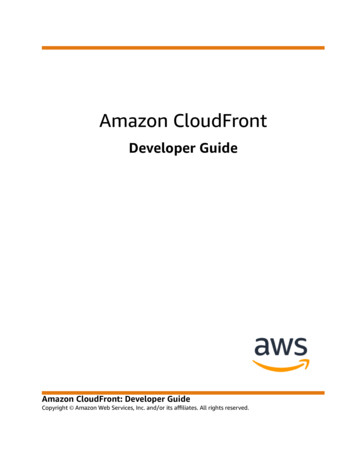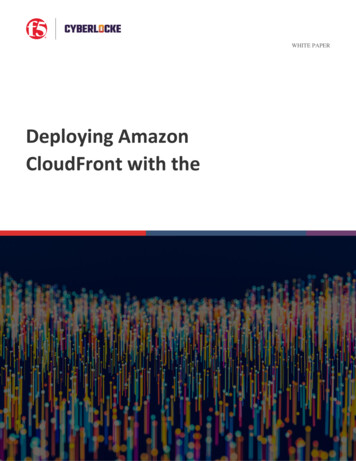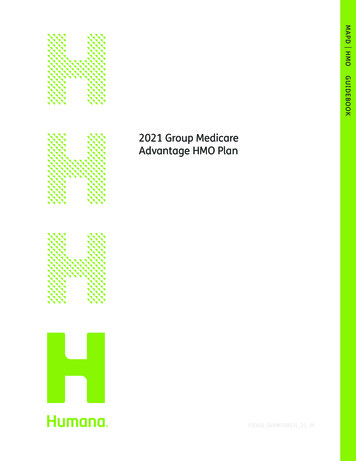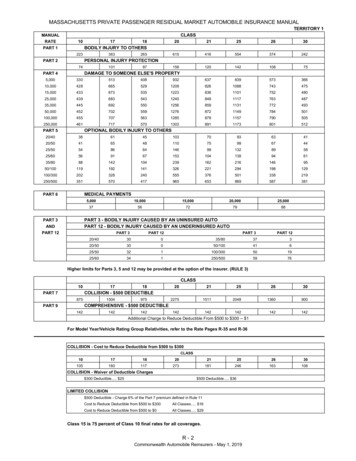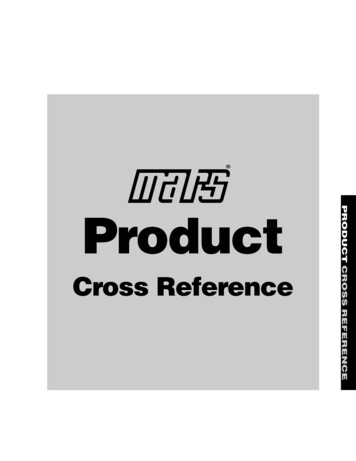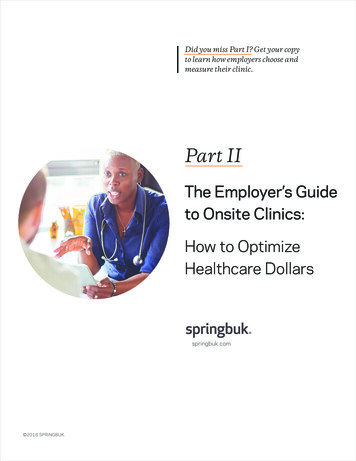
Transcription
Did you miss Part I? Get your copyto learn how employers choose andmeasure their clinic.Part IIThe Employer’s Guideto Onsite Clinics:How to OptimizeHealthcare Dollars springbuk.com 2016 SPRINGBUK.
Did you miss Part I? Get your copyto learn how employers choose andmeasure their clinic.ContentsIntroduction. 3Implementation Barriers. 3The Future of Onsite Clinics. 4What's Next for Onsite Clinics?. 7Request for Proposal (RFP) Checklist. 82
Our research identifies several hurdlesthat successful implementation plansmust address.Top Five Clinic Implementation Barriers:Employers vs ClinicsClinic Providers& ConsultantsEmployersIntroductionThe 2016 Healthiest Employers “Onsite WorkplaceClinic Survey” revealed a new role for onsite clinics.Part I of this Guide detailed the growth of clinics. Withthe rapid adoption of clinics, it's important to ask,"what are the implementation barriers?"In Part II, we’ll examine these challenges from theemployer and the clinic perspective. Part II willalso provide insight into where the future clinicmodel is headed, along with a Request for Proposal(RFP) checklist to help employers navigate thisimportant investment.Implementation BarriersOur research1 identifies several hurdles that successful implementation plans must address. While theirrankings vary slightly, employers and vendors sharea similar perspective on the most commonly facedchallenges during clinic implementations.31Healthiest Employer Strategic Assessment, 2016No budgetfor clinic¹Limitedphysical spaceLimited physicalspace²No budgetfor clinicMultiple employeelocations³Multipleemployee locationsEmployersize⁴Difficulty providingan ROIDifficultyproviding an ROI⁵EmployersizeSolutions for each of these barriers vary by workforce.For example, physical space limitations may make anear-site clinic more appealing. A limited budget mayargue for part-time clinic coverage, or a more limitedscope of services.The right vendor will demonstrate creativity andflexibility in working through these common issues.
70% of employers agree that "access tocare" has been achieved in onsite clinics40% want better targetedengagement of high-riskemployees40% of employers wantimproved wait times andtime spent by employeeswith providers35% want more accurateand timely reporting4
“35% want more accurate and timelyreporting [ . ] 40% want bettertargeted engagement.”The Future of Onsite ClinicsThe Employer PerspectiveOur study found that 70% of employers agree thatthe most fundamental goal of onsite clinics has beenachieved: “access to care.” However, while employersare fairly satisfied with staffing, appointment scheduling and efficiency of visits, almost 40% would like tosee improvements in wait times and in time spent byemployees with providers.Underscoring the importance of integrated data andpredictive analytics, about 35% want more accurateand timely reporting, and almost 40% want bettertargeted engagement of employees who are eitherhigh-risk or already living with chronic health issues.Opportunities & Gaps in the CurrentClinic Model1. Predictive analyticsToday, clinic vendors are bound, almost exclusively,by historical data. This “rear-view” perspectiveisn’t conducive for identifying and engaging at riskemployees. It also creates less actionable reporting.Predictive intelligence–defined by the ability to5forecast health and cost–allows employers to raisethe bar. These real-time insights make it possible toachieve much greater returns, both in financial ROIand employee health outcomes.2. Expanded integration of data“Big data” is driving innovation in many industries,and worksite wellness is no different. New datasources are emerging, along with the ability to unifythe “silos” of information. The modern day clinic andemployer can integrate clinical data with claims,pharmacy, fitness tracker, HRIS, payroll and otherwellness data. This blend allows richer insightsand improved targeting of clinic capabilities andinterventions to workforce needs.
26% of membershas a gap in careWhat’s more, 39%of future predictedhealth spend comesfrom these members3. Identification of gaps in care4. Optimized specialty careA narrow focus on activity metrics like office andurgent care visits, medical claims, and overall costsobscures an equally important driver of health costs:gaps in care.Comparing the effectiveness of different vendors,initiatives and interventions in the context of yourspecific workforce is powerful. A vendor’s ability toachieve results for other customers in other settingsis irrelevant—what matters is their ability to deliverresults for your workforce. Tools like Springbukgive employers a way to measure cohorts, or focuspopulations, to track program efficacy.Defined as the discrepancy between recommendedbest practices and the care that’s actually provided,gaps in care represent significant health savingsopportunities. In the average employee population,26% of members has a gap in care. What’s more,39% of future predicted health spend comes fromthese members.2Gaps in care harm health outcomes in two differentways. First, providers may fail to follow standard-ofcare guidelines in treating conditions. Second, patientsmay fail to comply with all aspects of an agreed-upontreatment plan.62Springbuk Analytics Population Study, 20165. End-to-end results analysis“Connecting the dots” between wellness initiativesthat occur outside the four walls of the clinic, likepedometer programs and weight loss challenges,has traditionally been a challenge. Now, combiningdata from longer-term clinical and health outcomesprovides executives with a comprehensive lookat the payoff from the organization’s investment inhealth and wellness.
Did you miss Part I? Get your copyto learn how employers choose andmeasure their clinic.What's Next for Onsite Clinics?The clinic door is now open for new and innovativeways to optimize clinic investments. Data-drivendecisions grow shareholder value by reducing healthcare costs and enhancing employee productivity,without compromising patient care or employeejob satisfaction.Opportunities for future synergies include:—— P ositioning the clinic as a one-stop integratedhealth hub for employee health and wellnessinitiatives, from fitness, weight loss, nutritionand stress management to primary care,chronic condition management and more—— U sing comprehensive, real-time, integratedand actionable data to manage the clinic notas a static list of services, but as a tool that isconstantly honed to capitalize on workforcehealth opportunities—— S hift in focus from simplistic participation andutilization to targeted engagement based onpredictive views of the conditions and costsmost likely to manifest in the workforce—— I nnovating solutions that allow employersto integrate occupational health withoutinviting EEOC, HIPAA or ADA claims, andwithout compromising employee trust intheir primary care provider73"A Fresh Look at Behavioral Health Benefits,” Mercer, 2016.—— I ntegrating clinic and telehealth capabilitiesto address behavioral health, which accountsfor 21% of healthcare costs but only 4% ofclaims3 and is out of scope for many clinics—— I mplementation of tools that provide anend-to-end view of the employee/patient’shealth journeyAs clinics partner with employers to provide end-toend stewardship of workforce health, more trends,opportunities and successes will emerge. The rapidadoption of clinics is matched by the rising toolsavailable to employers for them to program, measureand adjust like never before. For employers andemployees alike, the doctor is in.Ready topinpointReady to Optimize yourHealthcare Dollars?your spending?Get Demoinfo@springbuk.comLearn Morespringbuk.com
Request for Proposal(RFP) ChecklistClinic Management& Oversight ow is the overall success ofHthe clinic measured? ow are cost savings and producHtivity improvements tracked? ow are high-performing clinicHand non-clinic providers identified? hat are the vendor’s ongoingWquality control processes?Vendor ExperienceOperationsHow many primary care clinicsby state? ow many patients are seen on aHsame-day or same-week basis?How many occupational healthclinics by state? hat is the appointmentWscheduling process? What’sthe experience orfamiliarity with your industryor workforce? What is the average visit duration?Engagement & Utilization n average, how many eligibleOemployees use clinics in Years1 and 2? hat are the vendor’s patientWengagement programs and strategies, for both employees anddependents? ow is engagement tracked,Hmeasured and reported? hat is the vendor’s staffingWphilosophy and typical mix ofemployee and contract MDs,NPs, and other providers? n average, what are on-siteOpharmacy and lab utilizationrates and cost savings? hat is the average % of patientsWreferred to specialists? hat is the typicalWprovider-to-patient ratio? ow does the vendor handleHmultiple locations? an they support both on-site andCnear-site (shared services) models?Clinical CapabilitiesI s the clinic capable of servingas a medical home? hat is the scope of baselineWand optional services provided? hat is the vendor’s philosophyWregarding integration of occupational health?Population Health Management hat population risk assessmentWtools does the vendor use? hat health coaching programs areWavailable? What are the results? hat disease management proWgrams are available? What are theresults? ow does the vendor perform careHgap analysis of clinic data? ow does the vendor analyzeHclaims and perform predictive,future modeling?8 hat are the vendor’s qualityWreporting and patient/employerfeedback mechanisms? hat risk management policiesWand procedures help detect orprevent unnecessary treatmentor charges related to clinic ornon-clinic providers? (eg: clearlyexcessive claims paid to a largelocal provider group)Technology & DataIntegration ow are web-based appointment,HHRA, PHR and patient educationtools provided? Is the vendor’s EHR interoperable? oes the vendor provideDe-prescribing, online test ordering,and online access to results? ow does the vendor integrateHclinic data with other sourcessuch as biometric, activity tracker,carrier and pharmaceutical data? hat are the vendor’s “out of theWbox” reporting capabilities? ow rapidly is the latest dataHavailable for employer reviewand analysis?Other MattersI s the vendor involved in anypending litigation? as the vendor or its employeesHbeen the subject of any malpractice claims? as the vendor experienced anyHHIPAA or security breaches?
The 2016 Healthiest Employers "Onsite Workplace Clinic Survey" revealed a new role for onsite clinics. Part I of this Guide detailed the growth of clinics. With the rapid adoption of clinics, it's important to ask, "what are the implementation barriers?" In Part II, we'll examine these challenges from the employer and the clinic .



